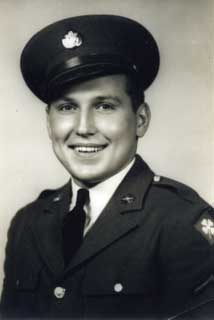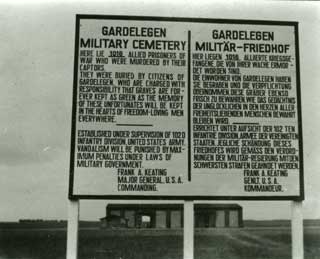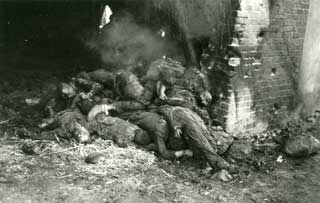Edmund S. Motzko: The Gardelegen Atrocity
Graphic content warning: Some of the text and images associated with this story are graphic in nature and are not suitable for children.
American soldiers who liberated Nazi concentration camps brought back stories of horrifying atrocities committed on Jewish and political prisoners. Edmund S. Motzko was with the 102nd Infantry Division when they encountered the slaughter that occurred at Gardelegen, Germany at the hands of retreating Nazi troops. Armed with a camera, Mr. Motzko brought home more than stories of the Gardelgen atrocity. In a 1982 oral history interview with Sandy Kibort, he remembered what he saw.
Oral History Excerpts
SK: What did you finally liberate? What did you come upon?
EM: The Gardelegen atrocity.
SK: Why were you in the area?
EM: We were at Bismarck, Germany one night, and we took over a creamery. This was shortly before we got into Gardelegen. And this creamery had fresh butter, and we thought that was great…The Germans didn't even know we were around.
…I think it was between Bismarck and – I can't remember the town – where we opened up these gates, where this one camp was, of slave laborers. We were just moving up to Gardelegen, just coming into it, when we were told about this atrocity.
SK: Who told you?
EM: Well, it was the 102nd Division that run into it, and then one of our battery units, a platoon or fighting unit, "D" battery of the 548th was with 'em, and they run into this. Then they told our commanding officer, and then the commanding officer relayed it to use, which I have in my records as Friday the 13th…This was April of 1945.
SK: Were you people ordered to go look at it, or get rid of the Germans around there?
EM: No, we weren't ordered to look at it. [Our commanding officer] says, "There's probably some of you people that won't – can't look at it!" But most everyone went. I know I went there twice.
SK: What compelled you to go there in the first place?
EM: Well, when he said, "You have to see it to believe it, and then after you see it, you still won't believe it!" I was quite curious! And it was something.
SK: Can you tell me what it was like?
EM: At this time, we already moved into Gardelegen. We took over a farm on the edge of town, and moved into this farm…and so from this farm we drove out – which was a mile to two out of town – to this atrocity. And it was something you would never forget, to see two piles of bodies still smoldering when we arrived was…You can imagine the stench, and everything. A lot of 'em couldn't stand it, got to the building and turned and walked away. But it didn't bother me too much, and I did go inside, and I walked around and looked at the bodies.
SK: What exactly did you see as you approached?
EM: Well, from the road it was a burnt-out building…You didn't have to get very close, and you could see the piles of bodies in the doors and stuff. Then I know I looked at this one – they had to open the doors enough, then, so I could see this one pile, and I walked down to the backside – and then I saw this other pile of bodies, still smoldering…And I had a camera which I had confiscated from a German, a Zeiss-Ikon…and I started taking pictures….After you get into combat, you weren't allowed to have any pictures. They were to be all censored, so the few pictures you did take, if there was a combat area, they were either confiscated, or they were held for you for so many days until you left the area.
But when we hit this particular area, he told us we could go see this and he told us all censorship restrictions were lifted and that we could take all the pictures we wished…But he says, "You can write home about it. You can give the name of the outfit, the name of the town and give any information you wish to and it will not be censored." And this was a first. So with that, we knew that this had to be something really terrible. And of course by then we had heard of some of the other atrocities, so we had a pretty good idea of what we were getting into.
…there was a scene on the inside – there was a kind of a ledge – cement ledge – and [it] looked like a father and son sitting there! And they died in that position with their arms around each other, and they knew they were going to die…and they had their little tin cans that they had for food and water sitting in between 'em and that's the way they died.
SK: What was the size of the building?
EM: I would say, 25 by 40 feet maybe. It was a large, tile building, with a tile roof…I think it was primarily used for where this agricultural area stored potatoes…It had a dirt floor.
SK: How many people were in it?
EM: In…this particular building, there were 1,016. They had marched 'em into the building and set up machine guns after they got 'em in there and closed the big doors and then they tried to set this fire. They had about a foot-and-a-half of straw on the floor that was saturated with gas, and the first round of attempt at setting it afire, they put out – they squelched the fire with their human bodies by laying on it. The second time they blew a hold in one end of the building with a Panzerfoss, which is a anti-tank weapon, and then from there they threw in various types of grenades – such as phosphorus – any grenade that would get things to burn. And then, also, in the same thing, they opened up with machine-gun fire to make 'em lay down, and with that the fire took off. And I think that – to add to some of the horribleness of this, looking at some of these bodies – they threw in phosphorus grenades. And wherever this phosphorus got on human skin, it just turned green…and continued to burn in the skin until it run out of oxygen or until it burned out. so there were some pretty horrible burns. (Sigh)
SK: Do you know what type of people they were?
EM: No, I really didn't, ya know…but now I can recall vividly…that they had the Stars of David.
SK: Was it all men? Or were they children?
EM: Well, it was all men. But there was some awful young-looking ones, too…They had buried 500 before we got there – I believe that this was going to be another atrocity covered up – had we not arrived, they'd had them all buried, and we probably wouldn't a known about it.
SK: The Germans were burying them?
EM: Burying them! Evidently they took slave laborers to bury these people. They buried them in tiers. After they get one tier, they'd cover 'em partly with ground, and then they'd start another tier. It was a bulldozed ditch right in back of the barn. It was better 'n half-full already. And for 500, that was approximately half of the people out of the thousand and sixteen. But then there was those that did escape them!
I came back again on the following day, and it was taped off…they found out that there was people turning themselves in that said they had escaped this atrocity – which was about eight or ten of 'em. And I was selected to guard these eight or ten because they knew that the Nazis would attempt to get somebody in to kill these people.
SK: What has this whole event done to you?
EM: Well, it's made me aware of the fact that this country we live in is just so darn great, and that people don't appreciate it. It's sad, to think that we've got something in the United States, [these] freedoms we have. To see what they can do to people in other countries, is just unbelievable. It makes you appreciate to have the freedoms we have.





Source
Motzko, Edmund S.; Sandy Kibort, Interviewer, Minnesota Liberators of Concentration Camps Oral History Project. Minnesota Historical Society Oral History Collection.


